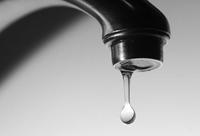-
Portable technology provides drinking water, power to villages, military
Researchers have developed an aluminum alloy that could be used in a new type of mobile technology to convert non-potable water into drinking water while also extracting hydrogen to generate electricity; such a technology might be used to provide power and drinking water to villages and also for military operations
-
-
West Texas towns face impending water shortage
West Texas is facing a dire drought that has local officials scrambling to find additional sources of water for thirsty residents; since last October, West Texas has only seen about one-tenth of an inch of rain, and now two of the three reservoirs that cities in the Permian Basin depend upon are nearly empty; the third reservoir is 30 percent below capacity; without significant rain soon, all three reservoirs will be dry by January 2013; residents have been restricted to only three days of outdoor watering; the region faces limited options for additional sources of water and plans will be expensive to implement
-
-
U.K. struggles to reduce water usage as supplies dwindle

An uncharacteristically warm and dry spring in the United Kingdom has forced water companies to begin conserving water, but a recent survey indicates that the method currently employed is widely unpopular and grossly affects low income families; some reservoirs are 20 percent below normal levels and eleven rivers are at their lowest in twenty years; in 1989 the British government mandated that all new homes have water meters installed and introduced a usage plan which charges households based on the amount of water they consume; the plan has proven effective in reducing water usage, but costs have increased by more than 50 percent
-
-
Beverage industry seeks to curb water usage
The beverage industry is actively working with researchers to conserve water as it requires vast amounts of water in its production processes; as much as 98 percent of the industry’s water usage comes from growing the ingredients used to make drinks; it is projected that by 2030 water demand will exceed supplies by 40 percent; analysts predict that water shortages will disrupt production and in times of scarcity can damage a company’s reputation; Coke has come under fire in India where residents blame the company for severe water shortages and improperly disposing of contaminated sludge; some companies are leading the charge and working with local farmers to help reduce water consumption and bolster local water supplies
-
-
Computerized irrigation system saves money

The University of Michigan is using a computerized irrigation system for its campus landscaping; the system uses information from a campus weather station that monitors wind speed, rain, temperature, and humidity to adjust irrigation schedules; the system allowed the school to reduce the amount of water used on irrigation by 22 million gallons of water on landscape irrigation each year — or 68 percent relative to the amount of water used before the system was installed — saving an estimated $141,000 a year
-
-
Algae could replace 17% of U.S. oil imports
Environmental and economic security concerns have triggered interest in using algae-derived oils as an alternative to fossil fuels; growing algae, however — or any other biofuel source — can require a lot of water; researchers at the Pacific Northwest National Laboratory the far less water is required if the algae is grown in those regions in the United States that have the sunniest and most humid climates: the Gulf Coast, the Southeastern Seaboard, and the Great Lakes; water-wise algae farming could help meet congressionally mandated renewable fuel targets by replacing 17 percent of the U.S. imported oil for transportation
-
-
Interest in water technology and business grows
Some 3,000 foreign visitors and more than 25,000 local participants are expected to attend the November 2011 WATEC, one of the world’s premier water technology events; the emphasis of this year’s conference and exhibition, the be held in Israel 15-17 November, will be on showing how water technology translates into successful projects and enterprises — both for the developed world and those at risk of severe water insecurity; there are about 400 water technology companies in Israel; 200 of them are already exporting their technologies to other countries — exports estimated to be between $2.5 billion and $3.5 billion in 2010
-
-
New material cleans water of radioactive contamination
NC State researchers develops material to remove radioactive contaminants from drinking water; the material is a combination of forest byproducts and crustacean shells; the new material not only absorbs water, but can actually extract contaminates, such as radioactive iodide, from the water itself; this material, which forms a solid foam, has applications beyond radioactive materials
-
-
Keeping water pure with detection nanosensors
Seven European countries, containing 35 percent of the European population, face a risk of water shortfall; University College Cork will coordinate a 3 million Euro EU project for the development of novel smart sensing materials for applications in water purification technology and clinical diagnostics
-
-
Wastewater-treatment system to produce electricity
Scientists will bio-engineer bacteria to break down large amounts of solid waste using anaerobic digestion (without oxygen) in a reactor based on existing technology used by distilleries and pharmaceutical companies; they hope to be able to capture the gas from the process to generate electricity. Because the system would not produce other waste products, they also hope it could improve wastewater treatment in the developed world
-
-
Heavy snows divert Colorado River water shortage, for now

This winter, heavy snowfall in Utah, Colorado, and Wyoming have helped to avert a water crisis along the Colorado River; after an eleven year drought in the region, residents have begun to worry about impending water shortages; the Colorado River supplies nearly thirty million people in seven states with drinking water as well as Mexico; the heavy snows could bring only a brief moment of respite; with demand exceeding supplies and with each year bringing less water, there is potential for a future disaster; if supplies continue to decline, water deliveries will be reduced when Lake Mead’s water level drops below 1,075 feet; as of 1 February, Lake Mead’s water level was at 1,091feet
-
-
"Solarball" promises to deliver clean water to developing countries

Contaminated drinking water is the world’s leading killer with more than 3.4 million people a year, including two million children, dying from water borne diseases; to help combat these preventable deaths, one Australian university student has designed an affordable solution to provide clean drinking water to people across the world; the device, called the Solarball, can provide up to three liters of clean water a day by harnessing the energy from the sun; the Solarball can be manufactured cheaply, is simple to use, and made of durable materials; it was designed specifically for use by people in hot, wet, tropical climates
-
-
After EPA fine, mining company building $200 million water treatment plant

America’s largest underground coal mining company, Consol Energy, is constructing a $200 million water treatment plant in West Virginia, after being fined $5.5 million by the Environmental Protection Agency (EPA); in 2009 discharge from Consol’s mining operation caused a toxic golden algae bloom that killed aquatic life along thirty miles of Dunkard Creek; the advanced waste water treatment plant will be the largest facility in Appalachia; the plant will be capable of treating 3,500 gallons of water per minute and will remove more than forty-three tons of dissolved solids, including eleven million pounds of chloride
-
-
Drought-prone pasts may foretell New York's and Atlanta's futures

By fall 2007, during the second year of a three-year drought, Atlanta had roughly three months’ supply of water remaining while Athens, Georgia was down to approximately fifty days; another drought dramatically lowered New York City reservoirs to 33 percent of capacity in 1981; droughts in those cities and their surrounding regions were typically longer and more frequent centuries ago than they were for most of the twentieth century; a return to historic climate patterns would bring more frequent and prolonged droughts
-
-
New tool to build water infrastructure resiliency
The Environmental Protection Agency (EPA) is set to roll out its new Community-Based Water Resiliency (CBWR) Electronic Tool this spring; the tool is designed to give organizations in charge of critical water infrastructure a way to assess their community’s ability to continue delivering water in the event of service disruptions and enhance resiliency; a major natural disaster or terrorist attack could leave large portions of a state without access to drinking water for months; Matthew Everett from the EPA will be present at the upcoming Government and Security Expo to discuss the EPA’s new initiative; the conference will be held from 29 March to 31 March in Washington, D.C.
-
- All
- Regional
- Water
- Biometrics
- Borders/Immig
- Business
- Cybersecurity
- Detection
- Disasters
- Government
- Infrastructure
- International
- Public health
- Public Safety
- Communication interoperabillity
- Emergency services
- Emergency medical services
- Fire
- First response
- IEDs
- Law Enforcement
- Law Enforcement Technology
- Military technology
- Nonlethal weapons
- Nuclear weapons
- Personal protection equipment
- Police
- Notification /alert systems
- Situational awareness
- Weapons systems
- Sci-Tech
- Sector Reports
- Surveillance
- Transportation
Advertising & Marketing: advertise@newswirepubs.com
Editorial: editor@newswirepubs.com
General: info@newswirepubs.com
2010-2011 © News Wire Publications, LLC News Wire Publications, LLC
220 Old Country Road | Suite 200 | Mineola | New York | 11501
Permissions and Policies
Editorial: editor@newswirepubs.com
General: info@newswirepubs.com
2010-2011 © News Wire Publications, LLC News Wire Publications, LLC
220 Old Country Road | Suite 200 | Mineola | New York | 11501
Permissions and Policies
